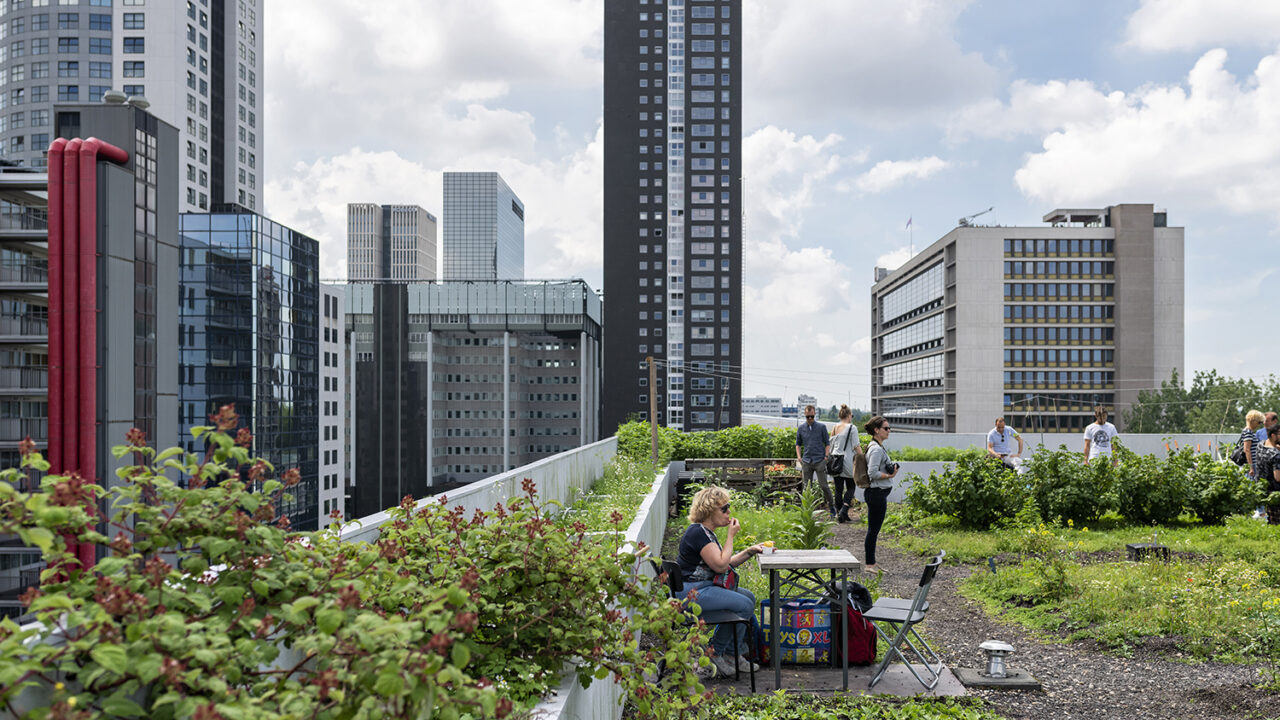What do you prefer: a morning walk where you only see asphalt and buildings? Or that same walk through a green neighborhood, where you see all kinds of nature, hear the birds chirping and see the water flowing? Most people choose the latter. That is also good for a person, according to numerous studies. This is how environmental psychologists came behind it that a walk through nature more often provides a better mood and more relaxation than a walk through a petrified neighbourhood. There is even research showing that people recover up to 10 percent faster from surgery if they have a view of trees instead of a stone wall. And there are many more advantages.
Green cities are hot, and a lot of research is being done into the possibilities. Among others by ecologist Robbert Snep. Snep is a researcher at Wageningen University & Research and has been studying green cities for 26 years. During that time he has seen the research field undergo a complete development. Snep: ‘When I started this topic in the late 1990s, people mainly looked for nature outside the city. Now the realization has dawned that greenery is also important within the city.’
But according to Snep, the fact that more and more people are realizing this does not mean that we will soon be living in a green oasis. There is a lot involved in ensuring that the greenery actually provides the benefits it can offer. And that is where things still go wrong in practice.
City of the future
What will the city of the future look like? More than 12 million people in the Netherlands live in cities, and that number is only going to increase. The city is a place where we live, live and coexist. But also a place where many of our social problems come together. What pain awaits the townspeople? And: is there a view we can hold onto? Journalist Tim de Jong will investigate how the city is changing and what we need to do in the coming months.
–
Slide to decor green
‘Municipalities are increasingly aware of the benefits of greenery,’ says Snep, ‘and that leads to great greening ambitions in the policy plans. Those plans then go through a field development machine: the city’s policy plans are translated into area plans, followed by a tender, a design phase and then the actual implementation and management. In that entire machine, dozens of people get to work with the plans. And that’s where it goes wrong.
To illustrate this, Snep uses a slide as a metaphor. ‘On the y-axis you can see the amount of greenery and the extent to which the greenery offers the benefits it can offer. On the x-axis you see the machine through which the policy plans go. With each step in that machine, we slide down that y-axis and get less green, with less quality, serving fewer functions. As a result, a petrified neighborhood is pooped out at the bottom of that slide, with only some decor greenery.’
Functional green
Cooling is a simple example to understand the functionality of green. You need shade to cool off on the street. A tree that has room to root and grow provides a lot of shade and therefore provides a lot of cooling (up to 10°). A narrow city tree with a tight fence around it (decor green) does that less. And certainly not a flat with a green facade.
Another good example are green roofs, which were recently introduced in the NRC were fired upon† According to Snep, the discussion about this exposes the problem exactly. ‘There is all sorts of research showing the – potential – benefits of green roofs. So it’s nonsense that we only look at green roofs through rose-colored glasses, like NRC stilt. The point is just: how do you arrange those green roofs in such a way that you also get those benefits? If you want a green roof to collect water, there must also be capacity for that water. This storage capacity can in turn ensure that plants have water when it gets drier, which in turn ensures evaporation and cooling. But that reception capacity is something that quickly falls apart in practice.’
That puts us right on the two main causes of why we slide down Snep’s slide: money and knowledge. A roof with good shelter capacity is more expensive. And it is questionable whether those who tender, design, make and manage the green roof know how important this capacity is.
This dynamic does not only apply to green roofs, but to all green policy plans. Snep: ‘Thousands of people work in the entire area development machine in the Netherlands. They are especially used to thinking about green that looks beautiful. Hardly anyone has any knowledge of what ensures that you actually get the benefits of green.’
The cost of green brings Snep back to the slide again. ‘In area development, green is only seen as a cost item. To the advantages there is no price tag for greenery for the climate, nature, our health and our well-being. The departments that start working on the green ambitions therefore only see costs, which means that the green space is cut more quickly and we slide further down the slide.’
That we are talking about big money is clear from the plans of the municipality of Utrecht. They have the ambition to grow by 60,000 homes, while at the same time maintaining the quality of life at the current level. Among other things, by creating 440 hectares of extra greenery in the city. The latter goes according to the calculations Cost 1.6 billion euros† Money that is needed to free up cables, pipes, infrastructure and land, and to design, organize and manage the green areas.
uneven green
The fact that green is mainly seen as a cost item also means that green is unfairly distributed across the city. Research by the WUR shows that people in poorer neighborhoods generally have less access to greenery: environmental inequity.
In cities, people with a high socio-economic status have on average 15 percent more greenery in their immediate vicinity (250 meters) than people with a low socio-economic status. This applies to both the amount of greenery and the quality of the greenery – can you swim, play or lie in the grass, for example?
If you look at a larger radius around homes (2.5 kilometers), the differences are smaller (10 percent). But this is not included how you get to that green spot, Snep explains. ‘Your immediate environment should also tempt you to go outside. For example, I live in a nice neighborhood, close to the park. For me the relaxation starts as soon as I step outside. That is very different if you first have to pass three traffic lights, busy roads and noise for two kilometers. With such an obstacle course, the threshold to seek out nature is much greater, both physically and mentally, so that you do it less quickly. As a result, people in poorer neighborhoods have fewer opportunities to enjoy nature, relax and find a cool place during a heat wave. And that in turn means that they exercise less, experience more stress and even need more medication.’
With the current housing crisis, we must be careful that these differences do not grow further. Snep: ‘When we build new homes, this is often at the expense of greenery on the outskirts of the city. And if you build high-rise buildings, you get more people who share the same piece of greenery. You then build cheaper houses, but you do create an environment where quality of life is under pressure.’
According to Snep, in order to change this, we need to start thinking about other forms of financing. Together with other experts, he is exploring how parties that benefit from greening can also contribute to the costs. For example, health insurers benefit if people live in green (and therefore healthy) neighbourhoods, but they do not contribute to investments in greenery.
He is also working on making the requirements imposed on construction projects by municipalities more concrete. And with WUR he tries to pass on knowledge in all kinds of ways to people who work in the area development machine.
We are at a tipping point, according to Snep: ‘It has to happen now. The energy transition and housing task also require space and a lot more attention is currently being paid to this. So if we don’t make room for greenery now, the space to make greener within cities will be gone. In doing so, we must ensure that we go from decorative green to functional green. We have to work really hard for that.’


